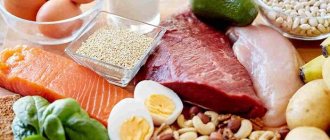The Institute of Nutrition of the USSR Academy of Medical Sciences developed the Soviet diet No. 8. She was subjected to serious clinical trials, which she successfully passed, and she was officially recommended to everyone who wanted to lose weight. It was proven that people who followed diet No. 8 sanatorium course (three weeks) easily lost 5 kg.
Today you can easily find dozens of different diets and techniques on the Internet, advice from popular people and stars, but the main difference between the Soviet diet No. 8 is that it is absolutely harmless and scientifically proven. After all, the diet includes all the essential and essential substances. A person who uses this method for losing weight does not experience hunger and feels great.
But how then will we lose weight if we don’t feel hungry? The whole point of the diet is that we give up fast carbohydrates and animal fats in our diet. We also refuse food that stimulates the appetite, canned food and spices. In Soviet times, nutritionists recommended having snacks at least six times a day, boiling food (you can also steam it), and ensuring that the calorie content of all dishes does not exceed 1900 kcal.
Modern grocery stores are significantly different from Soviet ones. They offer a wider variety of foods, so it is possible to follow Diet 8 and still replace some foods from the diet. Cod or pike can be replaced with dorado or sea bass, rosehip decoction with unsweetened freshly squeezed juice, white cabbage salad with a mix of fresh vegetables and green leaves, rye loaf with bread, coffee with green tea with jasmine, and peas with asparagus.
What are the benefits of Soviet Union diets?
It was in the USSR that the so-called tables appeared, which many have heard of. Number tables are still used in the treatment of various diseases. We must remember that the USSR was the first country that bothered to take care of developing a diet at the state level. Remember that Thursday was fish day in the USSR? All canteens fed workers fish dishes. This was the Decree of the People's Commissariat of Food Industry.
Moreover, then ordinary women did not have personal nutritionists, pills and weight loss products, or detox centers. But many actresses of that time had very good figures. And this is based not on overseas dishes, but on simple, widely available products and iron willpower. The list of Soviet diets will take more than one page, so let’s look at the most popular diets of the Soviet era.
70s
The main acquisitions of this period:
- The population's craze for sports. This is due to the Olympic hysteria and the program to popularize a healthy lifestyle. Almost all schoolchildren were members of some kind of sports club, and family vacations with sports overtones became a ubiquitous phenomenon. This was also greatly influenced by the fact that sportswear and equipment became generally available in the early seventies, and in addition, relevant literature appeared in abundance. The idea of a healthy nation runs through literally everything; is it any wonder that sport is also used as the main means of losing weight;
- Short skirts have also become fashionable for slender legs, which means for city bikes and long walks;
- “Kremlin” or “spectacles” diet. It is still widely used today. It must be said that ordinary citizens, especially those not living in the capitals of republics or large centers, could not afford most of the dishes described in the recommendations, therefore, in the popular version, “Kremlevka” was transformed into a protein diet. It must be said that for all its effectiveness, it created a large load on the digestive system and therefore was subjected to harsh criticism from many doctors. However, this did not stop fashionistas, because the glasses diet fulfilled the cherished desire of many women - to eat in excess and lose fat;
- Juices. If anyone thinks that there was no marketing in the USSR, then they are mistaken. The period of the seventies saw one of the most massive marketing campaigns of the Union - juice advertising. In addition to posters and lectures about the benefits of juice, there was also propaganda about using it for weight loss. The juice diet is popularly called “aristocratic”. Particularly advanced ladies even built a “health-improving” diet for a week exclusively on juices;
- "Mean diets." A popular name for meal plans, like the buckwheat or rice mono-diet, which have come back into fashion. Meager rations were called rations based on cheap, publicly available products, which was especially popular during the period of aggravated isolation of the USSR from the outside world;
- Among the harmful trends, it is worth noting the disposable meals that became widespread at the beginning of the decade. What is now considered the horror of office everyday life has become fashionable - eating exclusively as a snack with two snacks of tea and a sandwich during the day.
“Table number eight” according to Pevzner
Manuil Pevzner was the chief nutritionist in the USSR. It was he who decided that the best routine would be three meals a day. He is also the author of the idea of a three-course lunch: first, second and compote. Pevsner first developed the idea of "tables" which were used to treat common illnesses. Of these, table No. 8 stands out - the main diet of the USSR. It was used to combat obesity.
Stew, bake or boil foods, fried foods should not be eaten, reduce calories and eliminate fast carbohydrates - these are the basic rules of nutrition according to Pevzner. The conditions within table No. 8 allowed us to eat 5–6 times a day. If the case was advanced and the fat had to be removed quickly, the diet was reduced to 1200 calories, and the person was sent to a medical facility.
Prohibited foods included all baked goods, sugar and everything containing it. In addition to fast carbohydrates, you should not eat meat with a lot of fat, all confectionery products, semi-finished meat products, hot or fatty sauces, fatty milk products and some cereals (white rice and oats). The amount of salt was reduced and spices were minimized.
The approximate schedule of table 8 for the day looked like this:
- For breakfast we eat low-fat cottage cheese with vegetable salad.
- 3 hours after breakfast, the second breakfast comes, and here we eat a few apples.
- For lunch we eat borscht with lean meat. Only low-fat sour cream is added to borscht. As a second course, some boiled meat and stewed cabbage.
- For an afternoon snack we drink low-fat kefir.
- For dinner, boiled or baked fish, complement it with vegetable salad. Alternatively: buckwheat and steamed veal cutlet.
- Before bed, a glass of skim milk.
As you can see, this Soviet diet resembles proper nutrition with a priority content of protein products in the diet. The Pevzner diet is very gentle. You will not feel hungry. Weight loss on table No. 8 - 2 kg per month. The duration of such nutrition can be very long, even throughout life. It does not contain harmful carbohydrates, which in any case are healthier to exclude. According to BJU, everything is balanced - there is an abundance of vitamins, microelements and fiber. USSR diet products and menus can be changed to alternative ones. Fish for chicken breast, cottage cheese for natural yogurt and kefir.
Lyubov Petrovna and her diet
In the 30s, the idol of girls throughout the country was the famous actress Lyubov Orlova.
Naturally, everyone also wanted to become like her. — breakfast and lunch only; — two days a week on the water; - breakfast: a glass of water with lemon juice, two boiled eggs, a slice of bread; - lunch: 100 g of lean meat, some vegetables.
The actress never tried to adhere to any rules, but still, over time, this diet was given the name Orlova.
Mono-diet on parsley
After the end of the war, people who got rid of constant stress were able to think about proper nutrition again. And although after general militarization, sports figures “a la a girl with a paddle” became popular, after the appearance of Lyudmila Gurchenko, women began to desire a slender, thin figure. And the “Twiggy syndrome” did not bypass the Soviet Union.
Of course, other actresses copied Gurchenko’s image. And it was the fragile Lyudmila Markovna who began to appear on TV more and more often. Losing weight, as always, was not easy, and those who wanted to gain a slim figure came up with new diets. Although nutritionists advised against resorting to extreme methods, mono-diets have become very popular. And the Soviet diet based on parsley became the most popular.
But the discussion here was not about parsley leaves, but about the roots, which should have been eaten grated. The root was eaten three times a day. You cannot live long on parsley alone, so you could eat other permitted foods, but in small quantities, no more than 200 g per day. Those allowed included healthy sources of protein such as cheese, lean meats, eggs and dairy products.
Since, apart from parsley, there are no vegetables or fruits, vitamin deficiency may appear, and therefore you cannot go on a diet for a long time, like on any other mono-diet.
An approximate schedule for one day looks like this:
- for breakfast, one tablespoon of mashed parsley, washed down with tea or coffee;
- for lunch we take another tablespoon of root and 100 g of boiled meat;
- for an afternoon snack, along with a spoon of root, 100 g of dairy products, for example, cottage cheese or cheese;
- For dinner we drink a glass of low-fat kefir.
Sport as a way of life
In the forties, there was no question of rational nutrition - for 1418 long days the Soviet Union was in a state of war, and then eliminated its consequences. But in the 50s, active restoration of the country began. The party gave instructions to catch up and surpass other countries in everything, including sports. The USSR began to participate in the Olympic Games. This led to the development of women's sports. Even before entering school, children were involved in swimming, volleyball, rowing, etc. sections. And by the time they graduated from the 8-year school, thanks to constant physical activity, an athletic physique was formed.
The girls were slim and strong, and no one suffered from obesity or cellulite thanks to the fact that sports literally became a way of life.
They tried to save money: the couple bought a dilapidated house from the 30s and renovated it
The archive is open: the Allies played a double game and actively negotiated with the Nazis
I restored my old bedside tables: it turned out stylish
Plisetskaya's diet
Maya Plisetskaya is the most famous ballerina of the 20th century. In the 60s, a Soviet weight loss diet named after her appeared, which many believe was developed by Plisetskaya. It is difficult to verify whether this is true or not, but this power system was very popular in Soviet times.
It must be said right away that this system is not designed for long-term use; it is rather a plan for a fasting week. The program also had nutritional instructions after the diet - it was recommended to eat more fish and fiber, and also exclude salt from the diet, large quantities of which accumulate water in the body.
It was also recommended not to overdo it. After the fasting week, you could leave your favorite dishes in the diet if they were low-calorie. Meal times also mean little, and nothing was said about snacking or eating before bed.
On a fasting diet, eat three times a day. You can have snacks, but you can’t eat too much. For snacks, eat only non-starchy types of vegetables and fruits, such as cucumbers, tomatoes or citrus fruits.
An important part of this Soviet diet is exercise, which is necessary if weight loss is slow. The effect will not be as noticeable if you neglect exercise.
An example of a menu on this diet:
- For breakfast we eat 100 grams of Hercules cereal, boiled in water and without added sugar.
- For lunch - a plate of vegetable soup and 100 g of vegetable salad.
- For dinner, some baked fish and 60 g of rice. Garnish with fresh vegetables.
How to lose weight during the “Prisoner of the Caucasus”
In the 60s, the basis of the diet of ordinary Soviet citizens was cheap pasta and bakery products. The result is obesity. People sought to lose weight by increasing physical activity.

The Union began to lay down the principles of modern dietetics: do not eat after six, reduce the amount of carbohydrates, count calories. During the popularity of the heroine Natalya Varley from “Prisoner of the Caucasus,” mono-diets began to appear, very far from rational nutrition, based, for example, on only greens. It is clear that they ended disastrously for the stomach and for the health of the entire body as a whole.

Diet of fashion models in the USSR
In the Soviet Union there were no models, but fashion models. Let's remember them. Regina Zbarskaya, the most beautiful weapon of the Kremlin, Galina Milovskaya, Soviet Twiggy, Tatyana Mikhalkova, wife of the famous director, Leokady Mironov, who was one of the first to be offered contracts by Western agencies, Elena Metelkina, who starred in the film “Through Thorns to the Stars,” Tatyana Chapygina, the most popular model of the USSR, which always appeared on the pages of “Working Woman” and “Peasant Woman”.
The diet of Soviet fashion models was used by them before the show and limited caloric intake for three days. The sample menu used by the most beautiful models of the Union looked something like this:
- Breakfast – one soft-boiled egg.
- The second breakfast, which came three hours later, was 180 g of low-fat cottage cheese.
- Lunch, again after about three hours - 200 g of boiled poultry or palm-sized fish; you can supplement lunch with a glass of tea or a cup of coffee without sugar.
- Afternoon snack, three hours later, we eat a soft-boiled egg again.
- And after another three hours we eat 180 g of cottage cheese and tea.
As you can see, the diet is protein, and no carbohydrates.
We use this nutrition program for three days, apply it once a month. It will take 3 kg.
Moscow Art Theater diet
Actors and actresses have always strictly monitored their weight. The students of the acting department of the famous Moscow Art Theater were no exception.
– 1 day: 2 liters of fresh milk (short shelf life)
— Day 2: 2 kg of apples
— Day 3: 300 grams of cheese
— Day 4: 2 kg of vegetables (cucumbers, carrots, cabbage, tomatoes, etc.; season with a few drops of oil, lemon juice, spices, no salt)
— Day 5: 200 grams of boiled meat or fish
— Day 6: 200 g of cottage cheese, 2 hard-boiled eggs
— Day 7: 300 grams of cheese, 12 bottles of dry wine
This diet cannot be repeated more than once every couple of months, otherwise the body begins to wear out. Its effectiveness is quite high - in just a week, a fasting person loses up to 4 kg of excess weight.
Diets born in the USSR were very popular then, but they still work great today.
IMPORTANT! Informational article! Before use, you should consult a specialist.










